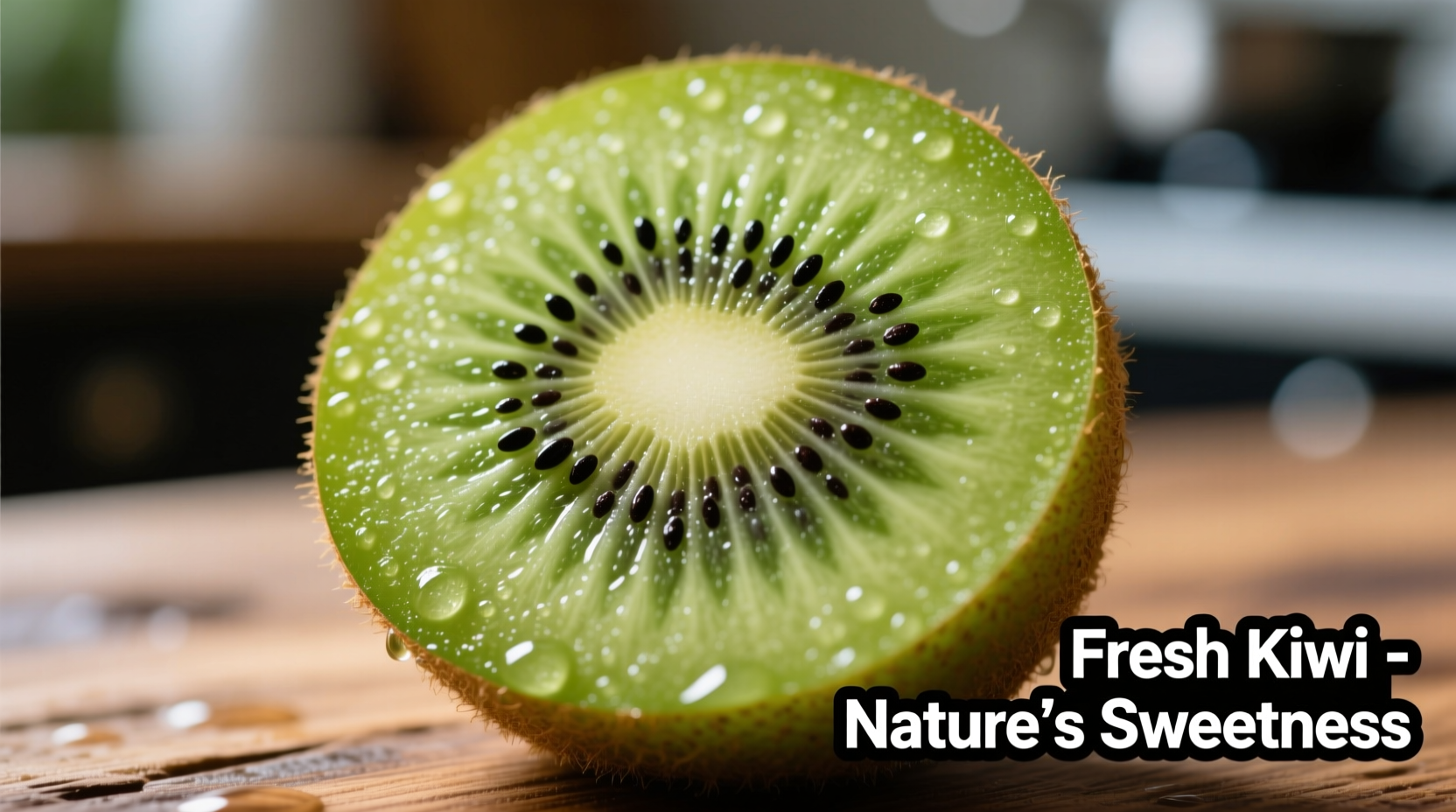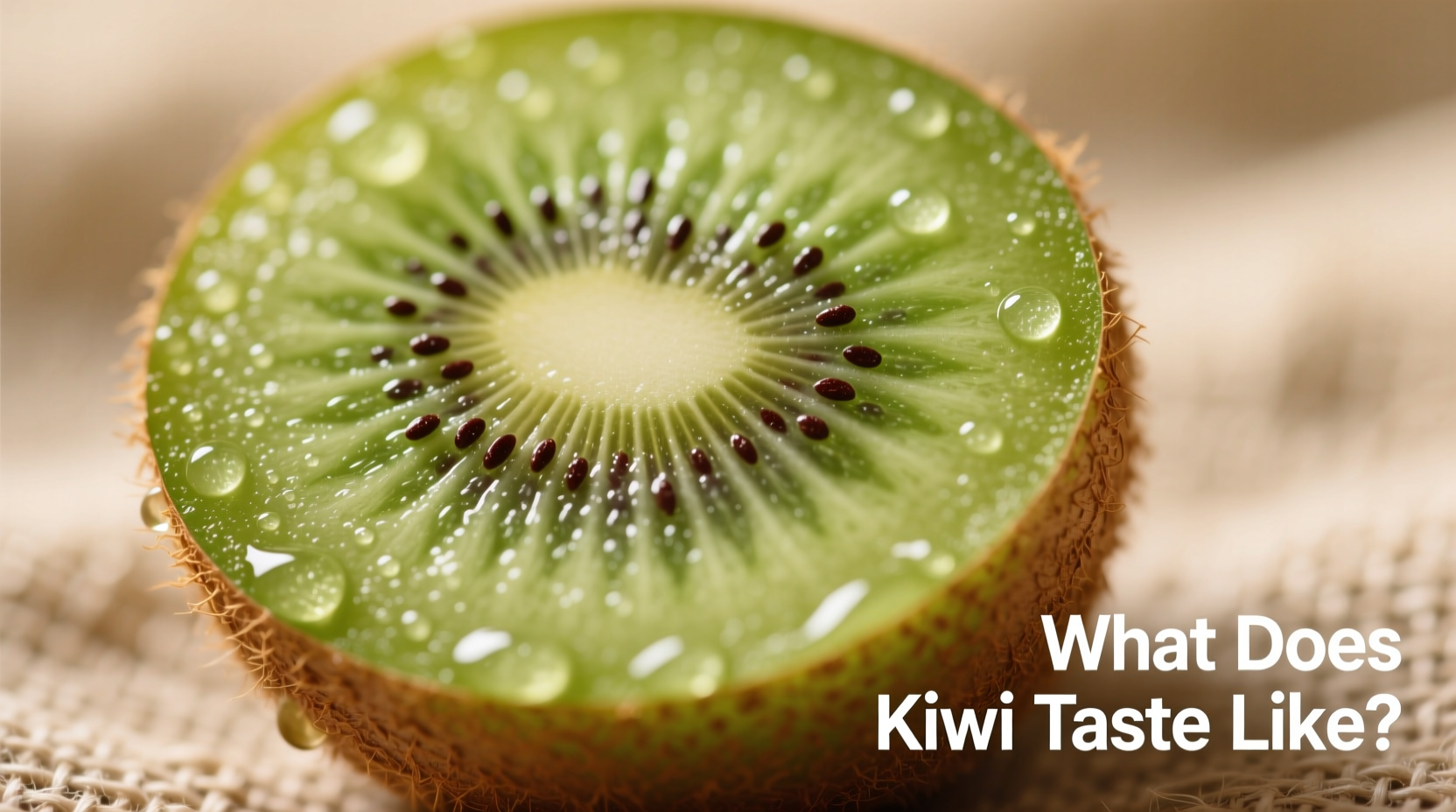Ever wonder what makes kiwi so uniquely delicious? This small green fruit packs a complex flavor profile that surprises many first-time eaters. Understanding kiwi's taste characteristics helps you select, ripen, and enjoy this nutrient powerhouse to its fullest potential. Whether you're deciding whether to try kiwi for the first time or looking to deepen your appreciation of this vibrant fruit, this guide delivers exactly what you need to know about kiwi's distinctive taste experience.
The Core Flavor Profile of Kiwi
At its essence, kiwi delivers a harmonious balance between sweetness and tartness. The predominant flavor notes include:
- Strawberry-like sweetness with tropical undertones
- Citrus brightness reminiscent of green grapes or kiwifruit's namesake, the Chinese gooseberry
- Subtle banana notes in the background
- Refreshing acidity that makes it incredibly palate-cleansing
The texture significantly contributes to kiwi's overall taste experience. Unlike smooth purees, kiwi's flesh contains hundreds of tiny, edible black seeds that provide a delightful pop with each bite. The fruit's jelly-like center transitions to slightly firmer flesh near the skin, creating a multi-dimensional eating experience.

How Ripeness Transforms Kiwi Flavor
Kiwi undergoes dramatic flavor changes as it ripens. Understanding this progression helps you enjoy kiwi at its peak taste:
| Ripeness Stage | Texture | Flavor Profile | How to Identify |
|---|---|---|---|
| Underripe | Firm, almost hard | Very tart, minimal sweetness, slightly bitter | Skin feels completely rigid when gently squeezed |
| Perfectly Ripe | Yields slightly to gentle pressure | Optimal sweet-tart balance, tropical notes emerge | Skin gives slightly but returns to shape |
| Overripe | Very soft, mushy spots | Excessively sweet, fermented notes, loss of bright acidity | Indentations remain after squeezing |
According to the New Zealand Kiwifruit Board, kiwi's sugar content increases by approximately 2-3% while acidity decreases by 25-30% during optimal ripening. This chemical transformation creates the perfect flavor balance most people enjoy. The board's sensory analysis shows peak flavor occurs when kiwis reach 14-16° Brix (sugar measurement) with pH between 3.1-3.5.
Green vs. Gold Kiwi: A Taste Comparison
While most people are familiar with the fuzzy green kiwi (Hayward variety), the gold-fleshed kiwi offers a distinctly different taste experience:
- Green Kiwi (Hayward): More pronounced tartness, stronger citrus notes, higher vitamin C content, traditional fuzzy brown skin
- Gold Kiwi (Zespri SunGold): Sweeter with tropical mango and peach notes, smoother texture, hairless skin, contains the enzyme actinidin which aids digestion
Agricultural research from the University of California shows gold kiwis contain about 30% more natural sugars than green varieties while maintaining similar acidity levels, creating their signature sweeter profile. Both varieties contain the enzyme actinidin, but gold kiwis have slightly higher concentrations which contributes to their smoother texture.
Context Factors That Influence Kiwi Taste
Several factors can alter what does kiwi taste like beyond just ripeness:
- Seasonality: Kiwis harvested in late fall through winter typically have better sugar development than off-season fruit
- Storage conditions: Refrigeration slows ripening but can mute flavor development if done too early
- Cultivation methods: Organically grown kiwis often develop more complex flavor compounds according to New Zealand's Plant & Food Research institute
- Individual taste perception: Genetic variations affect how people perceive kiwi's acidity and sweetness balance
Practical Tips for the Best Kiwi Taste Experience
Maximize your kiwi enjoyment with these science-backed techniques:
- Ripen properly: Store at room temperature in a paper bag with an apple to accelerate ethylene production
- Test for readiness: Gently squeeze near the stem - it should yield slightly when ripe
- Serve chilled: Refrigerate ripe kiwis for 30 minutes before eating to enhance flavor clarity
- Cut properly: Slicing horizontally preserves more texture contrast than vertical cuts
- Pair wisely: Complement kiwi's acidity with creamy elements like Greek yogurt or coconut milk
Professional chefs note that kiwi's flavor shines brightest when not overpowered by stronger ingredients. "Kiwi works best as the star of a dish rather than a supporting player," explains Antonio Rodriguez, chef and flavor specialist. "Its delicate balance gets lost when paired with intensely sweet or acidic components. A simple kiwi sorbet or kiwi salsa with cucumber lets the fruit's natural flavor profile shine."
Common Taste Misconceptions Clarified
Several myths persist about kiwi flavor that deserve clarification:
- "Kiwi should be sour" - Properly ripe kiwi has balanced sweetness, not overwhelming sourness
- "The fuzz affects taste" - The skin's texture differs but doesn't significantly alter flavor
- "All kiwis taste the same" - Gold varieties are distinctly sweeter with tropical notes
- "Brown spots mean it's bad" - Small brown spots indicate ripeness, not spoilage
When kiwi tastes unexpectedly bitter, it's usually underripe or has been stored improperly. The enzyme actinidin, while beneficial for digestion, can break down proteins in dairy products, which is why kiwi doesn't work well in traditional gelatin desserts or with milk-based ingredients.
When to Enjoy Kiwi for Optimal Flavor
Kiwi season runs from October through May in the Northern Hemisphere, with peak flavor occurring between December and March. During these months, kiwis have developed optimal sugar content while maintaining their characteristic bright acidity. Off-season kiwis often lack the complex flavor development of peak-season fruit.
For the most authentic kiwi taste experience, select fruit that yields slightly to gentle pressure but maintains its shape. Avoid kiwis with bruises, excessive soft spots, or an alcohol-like smell, which indicates overripeness and fermentation.
Understanding Kiwi's Unique Sensory Experience
What does kiwi taste like goes beyond simple sweet or sour descriptions. The complete sensory experience includes:
- Aroma: Subtle floral notes with green, grassy undertones
- Mouthfeel: Juicy flesh with delicate seed crunch
- Aftertaste: Clean, refreshing finish without lingering sweetness
- Temperature effect: Chilled kiwi emphasizes tartness, room temperature enhances sweetness
Food scientists describe kiwi as having one of the most complex flavor profiles among common fruits, containing over 30 distinct volatile compounds that contribute to its unique taste signature. This complexity explains why many people discover new flavor notes with each kiwi they enjoy.
Does kiwi taste better when cold?
Chilling kiwi enhances its refreshing quality and emphasizes the bright acidity, while room temperature kiwi showcases more of the sweet tropical notes. For optimal flavor balance, refrigerate ripe kiwis for about 30 minutes before eating.
Why does my kiwi taste sour?
Sour kiwi is typically underripe. Allow it to ripen at room temperature until it yields slightly when gently squeezed near the stem. The tartness should mellow into a balanced sweet-tart flavor as it ripens properly.
Can you eat kiwi skin?
Yes, kiwi skin is edible and contains additional fiber and nutrients. While the skin has a slightly more bitter, earthy taste than the flesh, many people enjoy the textural contrast. Gold kiwi varieties have smooth, hairless skin that's particularly pleasant to eat.
How do you make kiwi taste sweeter?
Allow kiwi to fully ripen at room temperature until it yields slightly to gentle pressure. You can speed ripening by storing with ethylene-producing fruits like apples or bananas. Avoid adding sugar as it masks kiwi's natural complex flavor profile.
What fruits taste similar to kiwi?
Kiwi has a unique flavor profile, but shares characteristics with several fruits: the tartness of green grapes, sweetness of strawberries, and subtle banana notes. Some people also detect hints of citrus and tropical fruits like guava in perfectly ripe kiwis.











 浙公网安备
33010002000092号
浙公网安备
33010002000092号 浙B2-20120091-4
浙B2-20120091-4